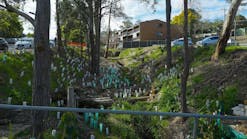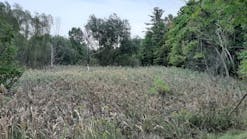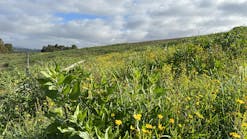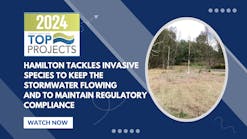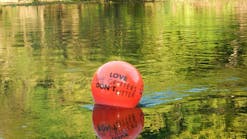Rolled erosion control products (RECPs), such as blankets and turf reinforcement mats (TRMs), are becoming hot market items as municipalities strive to meet more stringent government regulations. Increased awareness of their benefits boosts their use around the country. One cannot, however, simply throw an erosion control blanket over a slope and expect good results. Any project must be carefully designed, and precise installation guidelines must be followed for a positive outcome. How to ChooseHow do you choose what product to install? Factors to consider are slope, flow rate (if any), soil type, labor and maintenance, and cost. A program recently launched by the American Association of State Highway and Transportation Officials will test and evaluate RECPs. Some states already have lists of approved products.RECPs are usually classified by their longevity, ranging from short term to permanent. The longevity factor correlates to the components of the blanket and the application that it fits. A single-plastic-net straw blanket will last three to four months on average. Typical projects would include slopes from 3:1 to 4:1 and with low flow rates. Costs range from about $0.50 to $1.50/yd.2 A longer-term product would usually contain other natural fibers, such as coir (coconut) or excelsior (wood), which have a higher stress limit and more durability. These products are a good choice for drainage ditches and steeper slopes. Their longevity is one to two years, and the cost is up to $2.30/yd.2 Permanent products are often natural fibers sandwiched between synthetic, long-lasting nets. These TRMs are strong enough to be filled with soil and provide long-term protection to vegetation roots for permanent erosion control. They can be installed as shoreline or channel protection, along steep slopes up to 1:1, and in higher-flow spots. Costs range from $3.50 to $4.00/yd.2Some products intended for short-term erosion control employ photodegradable netting, which breaks down with exposure to ultraviolet light, or biodegradable netting, which breaks down with exposure to chemicals in the soil. These products are designed to last just long enough for vegetation to take hold. If the application has heavy shade, temporary products with photodegradable net should not be used. A biodegradable one will work better. Installation of RECPs typically involves grading the site and seeding it. The blankets are then rolled onto the area and anchored with staples and stakes, overlapping seams. TRMs can also be rolled over seeded soil, or topsoil can be added on top of the mat and then seeded. Some blankets have a seed layer already included.Stabilizing the Southeast
A Project under construction in Atlanta at Peachtree Hills Creek, a tributary of Peachtree Creek in the Chattahoochee River watershedThe nonprofit organization Southeast Waters, an AmeriCorps State Program in Georgia, recently worked on a streambank restoration project along a flashy tributary of Peachtree Creek in downtown Atlanta, GA. A neighborhood association requested that Southeast Waters undertake this project. A new nearby commercial project had changed the impervious ground ratio and, although the developer had taken steps to prevent damage, more creek stabilization was needed. The six-person crew began installing large rock, not riprap, along the toe. Jack White, director of Southeast Waters, states that he likes to use individual large rocks, carefully placed. Erosion control blankets are being installed along the bank of the 600-ft. stream. The soil, similar to that in most of the Atlanta area, is a mixture of sand, silt, and alluvial soils. The streambank is being seeded with seasonal grasses to provide quick growth and stabilization for the first year. After that, native plants will take over. “I’m a huge fan of erosion control blankets,” White remarks. “It would be impossible to do big projects without them.” The biggest problem is water getting under the top of the fabric and forming vertical channels underneath. If this happens, washout of soil occurs and the fabric often tears. Because it is critical to have good contact between the blanket and the ground, White says he uses “way more staples” than the manufacturer recommends. He also places live or dead stakes, including native trees and landscaping stakes. White notes that although staples provide the good ground ontact, they won’t always hold under storm events, and stakes provide the extra hold. The blankets are from RoLanka International of Stockbridge, GA, which specializes in coconut fiber products, according to Calista Santha, president of the company. “We use natural, biodegradable fibers,” she says, pointing out that coconut fibers are the longest lasting of the natural fibers and have the highest shear strength. The blankets are expected to last two to three years.New York School DaysA new middle school in Chappaqua, NY, was built on a hilly site with a trout stream running along one side. Colbond Geosynthetics’s Enkamat 7010, a three-dimensional TRM made with nylon filaments, was installed with about one staple per 2 yd.2 and then covered with topsoil. A seeded blanket was placed over the Enkamat with one staple per square yard. Full growth of vegetation was seen in less than four months.Midwest MethodsDwight Johnson, Midwest regional manager for Profile Products in Buffalo Grove, IL, describes the wide range of sites where RECPs are used. “They are very effective on slopes from four-to-one to two-to-one,” Johnson says of the company’s Futerra product. “The blankets are used in a broad spectrum of applications, including athletic complexes, roads, golf courses, mining reclamation, and landfills.” Futerra includes both biodegradable and photodegradable products. Depending on the time of year the blanket is applied, it can be mowed in six to eight weeks without danger of catching netting in the mower. Futerra RECPs are manufactured from wood fibers heat-bonded to synthetic netting. They have been tested at an 85-90% germination rate. The blanket matrix molds to the soil surface, providing critical ground contact. Newly seeded areas need to be moist, and the blankets can hold up to nine times their weight in water, Johnson says. Golf courses are among the largest customers for Ero-Tex in Milwaukee, WI. Scott Bordeau, president, says golf course contractors have learned that erosion control blankets are about half the cost of sod and less labor-intensive to install. The blankets also require less maintenance, including initial watering, and vegetation established in this way is more disease-resistant than sod. Ero-Tex supplies products by North American Green of Evansville, IN, to golf course contractors all over the Midwest. The DS75 Single Net Straw Blanket lasts about 45-60 days, providing strong growth but also degrading fast enough to not be caught in mower blades. Some projects require a combination of products, such as TRMs in the lower part of the slope and lower-performance blankets along the upper section. Bordeau says engineers can use North American Green’s Erosion Control Materials Design Software to determine what to use where by entering such variables as steepness of slope, type of soil, and amount of water flow. Ero-Tex also does a lot of business with state departments of transportation (DOTs). The State of Wisconsin has compiled an Erosion Control Product Acceptability List and updates it quarterly. The list can be accessed on-line or ordered from the DOT. For erosion control blankets, Wisconsin’s requirement is for independent testing from an accepted laboratory for shear stress, vegetative enhancement, and slope protection. John Warren, branch manager of ASP Enterprises in Fenton, MO, was a distributor for a huge project in Wichita, KS. Phases 1 and 2 of the Wichita Drainage Canal have been completed. Originally gabion baskets and riprap had been specified for the project but, as Warren notes, “Erosion control blankets and TRMs are gaining favor. They are easier to install and have cost benefits and aesthetic appeal.” The drainage canal now has a concrete bottom and gabion baskets up partway, and the 2:1 slopes are protected with North American Green’s C350 TRM, a high-strength, UV-stabilized triple-netting mat with a coconut fiber matrix. The seeds used have varied, depending on the time of year they are installed. Usually the choices are Bermuda or buffalo grass. Warren stresses, “You have to remember that none of these products works well without vegetation. It’s a whole system.”Warren sees three components to a good erosion control system. First – an absolute necessity – is proper design. Second is the installation. Many contractors skimp on staples or don’t prepare the soil well before the blanket is placed. A big advantage with North American Green blankets, according to Warren, is the system of paint spots to indicate correct staple placement. The third component is good maintenance. The site might need irrigation until the vegetation is established, and after that, mowing might be required. One recent golf course project proved the worth of RECPs. The Longaberger Golf Course in Newark, OH, experienced heavy summer storms soon after hydroseeding was completed on some swales with low slopes of 3:1-5:1 and on some steeper areas. The rainfall washed away seeds and soil, so the superintendent decided to try RECPs. North American Green’s S75, a lightweight straw blanket, was installed after seeding. Steeper slopes required the use of North American Green’s SC150, a straw-and-coconut blanket. In a few weeks, vegetation was established without risk of washout. Another golf course also provided a challenge. The Tournament Players Championship course in Blaine, MN, has several water features. The C350 heavy three-layer mat provides the extra protection the shoreline needs for protection against wave erosion.Colorado’s MountainThe road that winds up Pikes Peak in Colorado presents an interesting problem. In 2000, American Excelsior Company of Arlington, TX, and the Buckley Powder Company of Englewood, CO, began a plan to prevent erosion along the toll road. The pavement gives way to a gravel road above the 10,000-ft. level. Soils are decomposed granite with little organic material. Following federal guidelines to begin using as much postconsumer waste as possible, American Excelsior has developed Recyclex, a TRM made from recycled plastic drink bottles. Testing was performed at the Erosion Lab in Rice Lake, WI, and road tests began in October 2000.The test section of the toll road consists of roadside ditches about halfway up the mountain, at an elevation of 10,500 ft. A 9% grade with several switchbacks forms the roadbed. After grading, the Recyclex TRM was installed and staked into place. An anchor trench at the edge of the road covered the side of the TRM. About 1.5 in. of topsoil was placed on top of the TRM and seeded with native grasses. Excelsior Sediment Logs were installed about every 25 ft., and double-net Curlex II Excelsior blankets were laid over the seed. In May 2001, the site was inspected. Good vegetation growth was found, and snowmelt runoff and thunderstorms had produced little erosion. Grading operations and the annual Fourth of July road race had deposited some sediment, but the sediment-control measures had stopped the sediment within a few feet. Desert Sand In arid environments, where vegetation can take longer to become established, the material in RECPs might be visible for an extended time. Pyramat, a high-performance, UV-stabilized geotextile by SI Geosolutions in Chattanooga, TN, is usually black, but customers were requesting a product that would blend better with the environment. SI Geosolutions came up with a new tan version of the TRM. Engineers in Mesquite, NV, have already used 32,000 yd.2 of the tan version to line a channel that runs alongside a residential development. “Soil in this area is almost beach sand and very prone to erosion,” says Greg Osendorf, president and sales engineer at Attila Environmental Products in Sparks, NV. “The project was originally designed with 6-inch reinforced concrete, but changing to Pyramat saved approximately $1.2 million.”The FuturePete Hanrahan, manager of distributor development for North American Green, reports that the market for RECPs is expanding and that acceptance is growing as people understand that the product can save money over the life cycle. With tougher regulations, contractors are compelled to include stronger erosion control measures over the life of the project, and these products provide that at a reasonable cost and with an aesthetic, natural green look.
